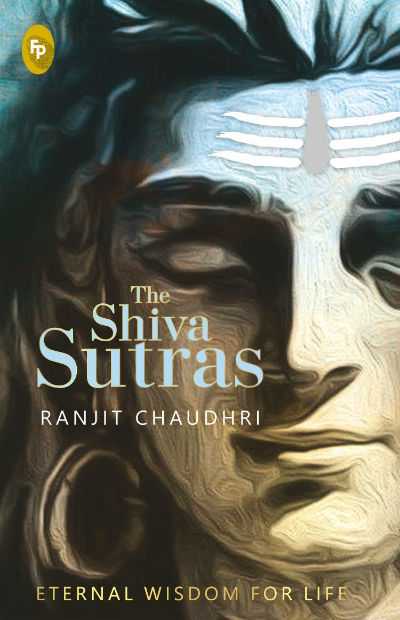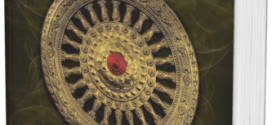The perks of being a professional book reviewer include a chance to explore various book genres.
This Is Here In For You
Listen To The Podcast:
If you love to listen to the book review over reading, or if you want to go through it while doing other activity, here is our Podcast of this review article. Do listen, and share your thoughts with us.
Spotify:
YouTube:
Today I am going to talk about The Shiva Sutras penned by Ranjit Chaudhri and published by Fingerprint! Publishing.
| Book Title | : | The Shiva Sutras (Eternal Wisdom For Life) |
| Author | : | Ranjit Chaudhri |
| Publisher | : | Fingerprint! Publishing (1 August 2019) |
| # of Pages | : | 144 (Paperback) |
| # of Chapters | : | |
| Purchase Link(s) | : |
Let us take a look at the book cover before we start exploring more deails about – The Shiva Sutras.
Book Cover:
If you the cover designer of this book what will be your first image for the same? Obviously you will try to illustrate an image of Lord Shiva doing his never-ending “Tapasya” in lotus pose, right? And then there can be an illustration of a leafy page where some words are written in Sanskrit. Another image you can have (if you know the legend of The Shiva Sutras) is, in addition to Lord Shiva, a sage is given some scriptures or shown directions by Lord Shiva;… Well, you can have your imaginations. but, let us look at what the designer of this book came out with.

The Shiva Sutras by Ranjit Chaudhri | Book Cover
Now check for yourself how much of your imagination matches with that of the cover designer. I found the cover page decent and attractive. It looks soothing, spiritual and eye-pleasing.
The Shiva Sutras – is actually an ancient Indian (that is Bharatiya) scripture, roots of which can be traced back thousands of years in the past. As per the legend, these Sutras were conveyed by Lord Shiva to sage Vasugupta in the eighth century. The Shiva Sutras are a collection of more than 100 Sutras (which are like lines or phrases) and is publicly available on the Internet.
१- शाम्भवोपाय
चैतन्यमात्मा । १-१।
ज्ञानं बन्धः । १-२।
योनिवर्गः कलाशरीरम् ।कलाशरीरम् १-३।
ज्ञानाधिष्ठानं मातृका । १-४।
उद्यमो भैरवः । १-५।
शक्तिचक्रसन्धाने विश्वसंहारः । १-६।
जाग्रत्स्वप्नसुषुप्तभेदे तुर्याभोगसंभवः । १-७।
ज्ञानं जाग्रत् ।जाग्रत् १-८।
स्वप्नो विकल्पाः । १-९।
अविवेको मायासौषुप्तम् ।मायासौषुप्तम् १-१०।
त्रितयभोक्ता वीरेशः । १-११।
विस्मयो योगभूमिकाः । १-१२।
इच्छा शक्तिरुमा कुमारी । १-१३।
दृश्यं शरीरम् ।शरीरम् १-१४।
हृदये चित्तसंघट्टाद् दृश्यस्वापदर्शनम् ।दृश्यस्वापदर्शनम् १-१५।
शुद्धतत्त्वसन्धानाद् वा अपशुशक्तिः । १-१६।
वितर्क आत्मज्ञानम् ।आत्मज्ञानम् १-१७।
लोकानन्दः समाधिसुखम् ।समाधिसुखम् १-१८।
शक्तिसन्धाने शरीरोत्पत्तिः । १-१९।
भूतसन्धान भूतपृथक्त्व विश्वसंघट्टाः । १-२०।
शुद्धविद्योदयाच्चक्रेशत्व सिद्धिः । १-२१।
महाह्रदानुसन्धानान्मन्त्रवीर्यानुभवः । १-२३।
२- शाक्तोपाय
चित्तं मन्त्रः । २-१।
प्रयत्नः साधकः । २-२।
विद्याशरीरसत्ता मन्त्ररहस्यम् ।मन्त्ररहस्यम् २-३।
गर्भे चित्तविकासोऽविशिष्ट विद्यास्वप्नः । २-४।
विद्यासमुत्थाने स्वाभाविके खेचरी शिवावस्था । २-५।
गुरुरुपायः । २-६।
मातृकाचक्रसम्बोधः । २-७।
शरीरं हविः । २-८।
ज्ञानं अन्नम् ।अन्नम् २-९।
विद्यासंहारे तदुत्थ स्वप्न दर्शनम् ।दर्शनम् २-१०।
३- आणवोपाय
आत्मा चित्तम् ।चित्तम् ३-१।
ज्ञानं बन्धः । ३-२।
कलादीनां तत्त्वानां अविवेको माया । ३-३।
शरीरे संहारः कलानाम् ।कलानाम् ३-४।
नाडी संहार भूतजय भूतकैवल्य भूतपृथक्त्वानि । ३-५।
मोहावरणात् सिद्धिः मोहावरणात् । ३-६।
मोहजयाद् अनन्ताभोगात् सहजविद्याजयः अनन्ताभोगात् । ३-७।
जाग्रद् द्वितीयकरः । ३-८।
नर्तक आत्मा । ३-९।
रङ्गोऽन्तरात्मा । ३-१०।
प्रेक्षकाणीन्द्रियाणि । ३-११।
धीवशात् सत्त्वसिद्धिः धीवशात् । ३-१२।
सिद्धः स्वतन्त्रभावः । ३-१३।
यथा तत्र तथान्यत्र । ३-१४।
विसर्गस्वाभाव्याद् अबहिः स्थितेस्तत्स्थितिः । ३-१५।
बीजावधानम् ।बीजावधानम् ३-१६।
आसनस्थः सुखं ह्रदे निमज्जति । ३-१७।
स्वमात्रा निर्माणं आपादयति । ३-१८।
विद्या अविनाशे जन्म विनाशः । ३-१९।
कवर्गादिषु माहेश्वर्याद्याः पशुमातरः । ३-२०।
त्रिषु चतुर्थं तैलवदासेच्यम् ।तैलवदासेच्यम् ३-२१।
मग्नः स्वचित्तेन प्रविशेत् ।प्रविशेत् ३-२२।
प्राण समाचारे समदर्शनम् ।समदर्शनम् ३-२३।
मध्येऽवर प्रसवः । ३-२४।
मात्रास्वप्रत्यय सन्धाने नष्टस्य पुनरुत्थानम् ।पुनरुत्थानम् ३-२५।
शिवतुल्यो जायते । ३-२६।
शरीरवृत्तिर्व्रतम् ।शरीरवृत्तिर्व्रतम् ३-२७।
कथा जपः । ३-२८।
दानं आत्मज्ञानम् ।आत्मज्ञानम् ३-२९।
योऽविपस्थो ज्ञाहेतुश्च । ३-३०।
स्वशक्ति प्रचयोऽस्य विश्वम् ।विश्वम् ३-३१।
स्तिथिलयौ । ३-३२।
तत् प्रवृत्तावप्यनिरासःतत् प्रवृत्तावप्यनिरासः संवेत्तृभावात् ।संवेत्तृभावात् ३-३३।
सुख दुःखयोर्बहिर्मननम् ।दुःखयोर्बहिर्मननम् ३-३४।
तद्विमुक्तस्तु केवली । ३-३५।
मोहप्रतिसंहतस्तु कर्मात्मा । ३-३६।
भेद तिरस्कारे सर्गान्तर कर्मत्वम् ।कर्मत्वम् ३-३७।
करणशक्तिः स्वतोऽनुभवात् ।स्वतोऽनुभवात् ३-३८।
त्रिपदाद्यनुप्राणनम् ।त्रिपदाद्यनुप्राणनम् ३-३९।
चित्तस्थितिवत् शरीर चित्तस्थितिवत् करण बाह्येषु । ३-४०।
अभिलाषाद्बहिर्गतिः संवाह्यस्य । ३-४१।
तदारूढप्रमितेस्तत्क्षयाज्जीवसंक्षयः । ३-४२।
भूतकञ्चुकी तदा विमुक्तो भूयः पतिसमः परः । ३-४३।
नैसर्गिकः प्राणसंबन्धः । ३-४४।
नासिकान्तर्मध्य संयमात् किमत्र संयमात् सव्यापसव्य सौषुम्नेषु । ३-४५।
भूयः स्यात् प्रतिमीलनम् स्यात् ।प्रतिमीलनम् ३-४६।ॐ तत् सत्तत् सत्||
So, while it is available to read for free, why should one go ahead and pay for a book on the same? Well, – the Shiva Sutras – as you can see are small idiom like phrases that hold a treasure of knowledge within. But, to understand the message within, one needs guidance from someone learned. Otherwise, it is easy to misinterpret the same.
For example:
ज्ञानं बन्धः । १-२।
Doesn’t it contradict the popular belief: “knowledge liberates”! This is what we’re taught since the early childhood days right? I remember, having a logo with the words “सा विद्या या विमुक्तये” printed on my school books! And, yes, we know that in real life, knowledge is the best resource one can possess. So, why Shiva Sutra tells the opposite? Well, it doesn’t! It actually meant to say that “incomplete knowledge is harmful”!
I found this book a good resource where all these Sutras are explained in detail. It allows us to explore the actual message this treasure of knowledge is meant to convey. some of the Sutras are explained in a single page while some of them are explained even in 4-5 pages, based on the complexity of the message it contains.
The author has really done hard work in explaining these sutras and coming up with examples and backreferences where needed.
In this time when we read a lot of books on ancient scriptures being explored from different perspectives, it feels good to see something lesser-known explored in a simple yet effective manner. Ours is the culture where the truth seekers and knowledge holders are respected beyond everyone and everything else. The real treasure mankind possesses is not located in the mines of gold or diamond or any other such composition, it is the scriptures holding knowledge, wisdom and life lesson. That’s why I like the way the book is dedicated to those who saved these Shiva Sutras, even in difficult times we cannot imagine. It reads
To the brave Kashmiri Pandits, who preserved this ancient text for the benefit of all mankind.
The book also contains a Photograph of Shankarpal – the stone on which the Shiva Sutras were inscribed. It is found in a stream in Danchigam National Park which is situated outside Srinagar. While no one to our knowledge has seen the covered side of this stone, it is not possible to say whether the Sutras are written exactly as they are mentioned everywhere on this stone, or are written in a different language like Prakrit, Pali, Kashmiri,… or any other. But, this photograph somehow adds to the authenticity of the scripture.
I would love to talk about many attributes of the book by quoting lines and segments I like; but, it will then contain spoilers that I consciously want to avoid as much as possible. I, however, must say that I like the conversation of “Dualism :: Non-dualism” in this book. The way it talks about, how we tend to consider everything from the perspective of physical appearance rather than the immaterial stuff with an example: we identify ourselves by our bodies, while the true self of a person is his/her soul, the energy which keeps his body going.
The book has some limitations too. Well, I cannot comment on the examples the author has explored or some explanations which I found could have been better; as it is his domain and he is entitled to explore his vision. Which, of course, he did quite well. In my opinion, the should have included the original Sanskrit Sutras in the chapter titles. He used phonetic English versions instead.
I like the way the book is formatted. The fonts are a little bigger and thus are more readable. The author has included a bibliography at the end which is also a positive aspect of the book. I also like the way, all the sutras are listed at the end of the book, however, I think he should have included them in the beginning and should have used them as a table of contents. The book is distinguished into three segments in the same way the Sutras are grouped in the original resources (available). Thus they remain consistent with the source.
Let me add the disclaimer that the book is provided by the publisher in exchange of genuine and unbiased book review and the review is uninfluenced by all means, as always.
Summary:
I like this book. It is, however, not for everyone. If you love reading something full of wisdom which has a spiritual inclination, this book is a good choice.
Around 7.5 out of 10.
Over To You:
If you already have read the book do share your remarks and thoughts via comments below. Does this review help you in making your decision to buy or read the book? Do not forget to share this article with your friends over various social networks via Twitter, Facebook and others. And yes, you may like to subscribe to our RSS feeds and follow us on various Social networks to get latest updates for the site to land right in your mail box.
 ThinkerViews – Views And Reviews Personal views and reviews for books, magazines, tv serials, movies, websites, technical stuff and more.
ThinkerViews – Views And Reviews Personal views and reviews for books, magazines, tv serials, movies, websites, technical stuff and more.




